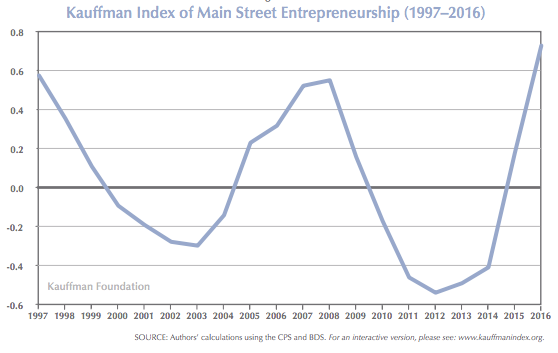Donald Trump will inherit a robust economy
Main Street is finally catching up to Wall Street.
After several years of dismal performance, a key indicator of small-business health has jumped to new highs. The Index of Main Street Entrepreneurship, calculated by the nonprofit Kauffman Foundation, recently hit the highest level since 1997, when the organization began taking measurements. The biggest improvement in 2016 was a rise in the new business survival rate, with nearly half of all new businesses making it to their fifth year.
There are many other signs of a strong economy getting stronger, which highlights an obvious irony: Donald Trump got elected president this year by continually accentuating problems faced by many Americans who feel they’re falling behind. Yet he’ll inherit an economy that is far healthier than the one President Obama started with eight years ago, in the midst of a grueling recession.
Employers have created about 5.4 million new jobs during the last two years, and they’re on course to create nearly 4 million more during the next two years, according to economists at the University of Michigan. Unemployment-insurance claims filed by people losing their jobs are well below levels from before the recession that began in 2007. Construction of new houses and retail sales look strong. Wages are rising as well, with the Federal Reserve now likely to hike interest rates at its next meeting in December. That would be a sign the Fed finally feels the economy is healthy enough to tighten monetary policy.
These charts show everything going in the right direction:



So why did Trump’s appeal to the “forgotten men and women” of America get so much traction, if the economy’s doing great? Two reasons. First, a lot of people who are doing fine voted for Trump. Not because they need help climbing out of a hole, but because they agree with him that the US political system is broken and dominated by crony capitalists.
The second reason is that the overall economy is getting back to normal with less participation from people who are unsuited to a digitized, global economy—and are, in fact, falling far behind. Nicholas Eberstadt, a scholar at the American Enterprise Institute, has highlighted the problem of 9 million “missing men” who don’t have jobs and don’t want them, even though they’re at prime working age. Millions more are trying to support families on inadequate wages, with no obvious way to get ahead. Trump has oversimplified the solutions to these complex problems, but he also convinced people he heard their complaints.
With the wind at his back as he takes office in January, it might seem like Trump will coast through the next four years and get credit for an economy that’s strengthening on its own. But Trump could end up with the opposite situation. The average business-cycle expansion since 1945 has lasted about 5 years. The current expansion has been underway for 7-and-a-half years. So in terms of raw timing, we’re due for a recession. The longest postwar expansion lasted 10 years, from 1991 to 2001. Trump’s fourth year in office would mark the 11th year since the current recovery began in 2009.
Presidents get credit or blame for economic developments they often have little control over. Obama took office about two-thirds of the way through a brutal recession, but the recovery that unfolded during most of his time in office was slower than any other during the last 70 years. It seems to be accelerating now, which could end up being a stroke of luck for Trump—or plain old bad timing.
Rick Newman is the author of four books, including Rebounders: How Winners Pivot from Setback to Success. Follow him on Twitter: @rickjnewman.

 Yahoo Finance
Yahoo Finance 
